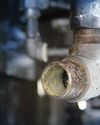CATEGORIES
Kategorien

Environmental Training: How to Get Your Team Onboard
Most of the facilities we enter as consultants have pretty strict environmental standards that the facility must uphold. The Environmental Protection Agency (EPA) does NOT play around when it comes to industrial plants.

Onsite Labs vs. Offsite Labs: Which is Best for My Lube Program?
With facilities running on leaner staff, increased run times and the expectation of fewer failures, quality data from lubricant analysis has only grown in importance. By looking at the data contained within an oil or a grease sample, we can determine if the lubricant and the machine are still healthy and ultimately make maintenance decisions that impact one or both.

Little Known Sources of Contamination Ingression
You are probably familiar with a lot of the different ways contaminants can find their way into your machinery. For example, one of the most common ways that contaminants enter your lubricant is through poor headspace management.

Oil Cleanliness: On-line Condition Monitoring
Technology innovations and success stories

Lubricant Selection and LIS: Fight the Current Lack of Supply
Jim Fitch wrote a pretty comprehensive article recently, going into the finer minutia of what to do when you can't get the lubricants that you normally use. I wanted to take some time and give you a pretty good strategy to help mitigate some of the woes of having to swap suppliers to get the lubricants that your machines need for proper operation.

ONSITE OIL ANALYSIS DRIVES DOWN MAINTENANCE COSTS
In a recent plant reliability survey, 60% to 70% of industrial facilities consider oil analysis an important part of their reliability programs. Oil analysis gives a snapshot of machinery health, preventing unnecessary oil changes and assisting in predicting equipment failures. This article will take a detailed look into using data to decrease maintenance costs and increase the bottom line.

Contamination Control Objectives: Cleanliness And Dryness
With contamination being the leading cause of machine failure, one of the most important sections of a lubrication program is contamination control

Risk Management: Comparing Human Health With Equipment Health
As the title would suggest, comparing human health to equipment asset health reveals some striking similarities, but also uncovers differences that should be considered

LEAN MANUFACTURING EXPLAINED
Lean manufacturing or \"going lean,\" refers to a series of methods, philosophies and tools to minimize waste in your business and maximize production. Read about different ways your company can go lean

Oil Analysis Pitfall!
For better or worse, our world is very connected

Machinery Configuration
Quick Wins that Optimize Machine Performance

The Value of a Platform Lubrication Dedicated to Program Management
With an industry increasingly focused on improving machine reliability through the deployment of best practices in lubrication and oil analysis, there is a need to establish better management tools to accomplish these objectives

KPIs to Ensure Proper Lubrication Selection
With the movement to digital solutions for tracking and managing most decisions that are made in reliability and maintenance, an area that is often left out is lubricant selection

Make Touchstones of Lubrication Excellence Shine
Almost subconsciously, our senses gather information on our surroundings

Hindustan Petroleum Corporation Ltd (HPCL) has entered into an agreement with Chevron
Hindustan Petroleum Corporation Ltd (HPCL) = has entered into an agreement with Chevron to manufacture, distribute, and market lubricants in India.

Avoid Over-Filtration: The Importance Of Optimization
Maintenance is the single most controllable expense in a facility. These words have been quoted time and time again, vis-à-vis controlling equipment failures.

The Importance of Proper Food-grade Lubricants
Optimal lubrication is acritical consideration in any production process. In food and beverage production specifically, a balance must be struck; machinery lubricat ion and food safety are both important.

How to Detect, Treat and Prevent Microbial Contaminants in Lubricants
Also called microorganisms, microbes are microscopic living organisms that can be beneficial or detrimental to human health.

What's in the Box?
I’ve spent the past week helping a client get their lubrication program back on track.

Lubricant Consolidation and Optimization: Which Lubes Stay and Which Lubes Go?
Lubricant consolidation is the practice of selecting lubricants, stocking only what is necessary for optimal machinery performance on-site.

POD RACING - Fluid Monitoring in Formula One™
While sending oil or fluid samples off to the lab is a great way to verify the cleanliness of your fluids and the health of your equipment, the process takes time.

Are You Ready?
Supply-chain Problems Spark the Need for Backup Lubricants

The Seven Levels to Lubrication Excellence
"Once begun, you're halfway done."

The Future of Mobility - Klüber Lubrication
Klüber Lubrication showcased their state of the art solutions at the Auto Expo Components 2023 (January 12th to 15th, Pragati Maidan, New Delhi).

Must be Something in the Water: Aqueous Toxicity
ENERGY CONSERVATION, HEALTH & ENVIRONMENT

Particle Counting: Why Smaller Particles Lead to Big Trouble
CONDITION MONITORING, LUBRICANT ANALYSIS AND TROUBLESHOOTING

Aeration and Foam: Good for Beer, Bad for Oil
CONTAMINATION CONTROL & LUBRICANT RECONDITIONING

How to Sell a Lube Program to Plant Management: In a Word - Creditability
\"Creditability goes beyond what people say to sell us on ideas by adding past performance to predict future performance. Creditability is therefore earned.\"

Five Common Mistakes Made when Developing an Inspection Route
Developing and implementing inspection routes is a key part of a successful lubrication program.

LUBE-TIPS
The \"Lube-Tips\" section of Machinery Lubrication magazine features innovative ideas submitted by our readers.